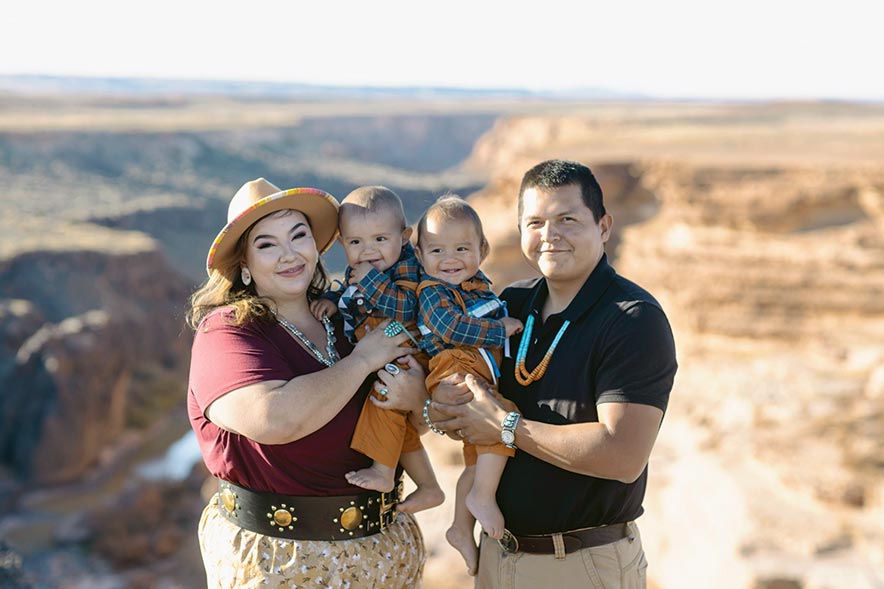
Reporter’s Notebook | Humor, teaching on YouTube: Couple combines cultures, twin boys to draw subscribers

Courtesy photo Darwin Begay and Angel White Eyes, known as Navajo Man and Lakota Bae on YouTube, with their twin boys, Nataanii Nabaahi and Hashke Nalanii.
GALLUP
Darwin Begay and Angel White Eyes, also known as Navajo Man and Lakota Bae, started their YouTube channel at the beginning of the COVID-19 pandemic and have amassed a total of 11,100 subscribers.
Begay, 31, is from Teesto but now resides in South Dakota with his partner and two kids.
He is T?’ááshchí’í, born for Naakai dine’é. His maternal grandfather is Tódich’ii’nii and his paternal grandfather is Táchii’nii.
White Eyes, 32, is from Pine Ridge and is Oglala Lakota.
The couple has been together for six years and met through mutual friends during the Black Hills Powwow in Rapid City, South Dakota.
“One visit was enough then I got captured,” Begay jokes.
The pair was inspired to start their channel after watching other Navajo YouTubers like Sierra Johnson and Natalie Franklin.
“All of a sudden we started recording ourselves, like vlogging, and it turned itself into a vlogging channel,” Begay said.
The videos vary from showing their daily lives to displaying their cultural backgrounds.
“We show different cultures, we have a lot of Navajo viewers and other tribes and other cultures around the country and around the world,” Begay said.
Since their viewers are of different backgrounds, mainly Navajo, he said showing them Lakota culture helps to show a different tribal nation than what they are used to.
“Bringing their culture (Oglala Lakota) out into the internet, you know, the YouTube world, it gives everyone a different perspective,” Begay said. “Different reservation, different culture, different language. I guess it’s kind of educational as well.”
White Eyes said their channel also shows how she and Begay blend their Lakota and Diné cultures together to raise their 14-month-old twin boys.
“We each have our own traditions but then sometimes we have similar traditions as well, so we show how we bring that together in our videos,” White Eyes said.
Begay said many things are similar and they participate in each other’s ceremonies. He said the only difference seems to be the place where ceremonies are held and the landscape.
They began to pick up more viewers and subscribers as the pandemic went on and lockdowns were imposed.
Twins draw subscribers
He pinpoints the exact moment they started gaining subscribers at a rapid pace and it was when the couple announced the pregnancy of their twin boys, Nataanii Nabaahi and Hashke Nalanii.
“I guess it blew up right after we found out we were having twins, that’s when our channel took off,” Begay said.
“It’s been kind of crazy and kind of like a blessing at the same time,” White Eyes added.
She said their subscribers sent stuff for the babies and helped prepare them for parenthood.
“From our subscribers, they’ve been really helpful to us in becoming new parents like they would send us gifts for the boys before they were here and stuff we would need as new parents,” White Eyes said. “And just like all their words of encouragement and the comments we have on our videos really kept us going on out vlogging.”
In return, the couple has been teaching and helping their viewers in a different way.
White Eyes recalls a time when they hosted a meet-and-greet in Tempe.
“We had this young girl come up to us and she said that she was really learning her language,” White Eyes said. “She was Diné, from Darwin because Darwin really speaks Diné in our videos. It was really helping her learn her language and she was really appreciative of that.”
Begay said they start their videos out with smudging with white sage and they have recent received comments thanking them for smudging.
“They (Native youth) have been commenting and reaching out to us, saying that doing things like that (smudging with white sage) even though we’re from a distance and just on YouTube has been helping them,” Begay said.
Other Native people are not the only ones impacted positively by the couple’s channel.
Since they have viewers from other countries like Australia, Germany and South Korea, they’ve been educating and showing these viewers how modern day Natives live.
“There’s this one person that’s only seen us on TV and seeing us in a modern day world, like we don’t live in hogans or teepees like how the media perceives us as,” Begay said. “We change that perspective and they see us as regular human beings.”








 Highway 264,
Highway 264, I-40, WB @ Winslow
I-40, WB @ Winslow